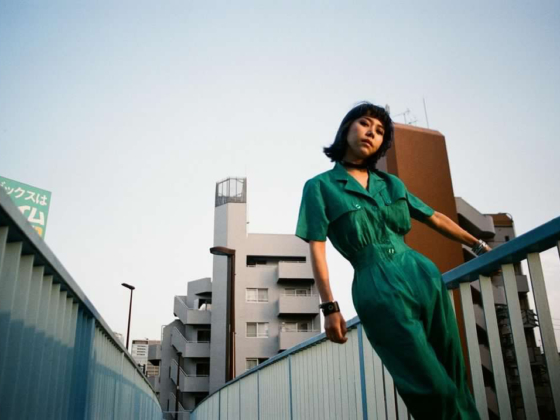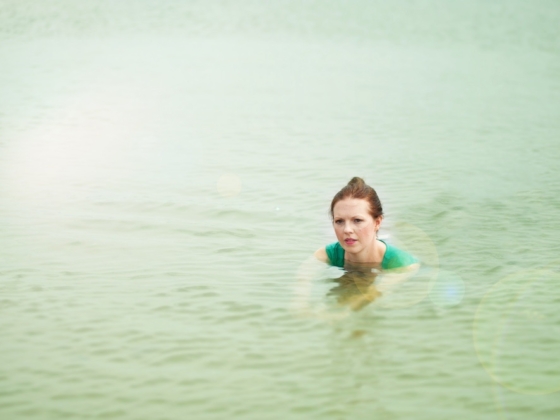Dynamic duo Enid Ellen take us through a world of internal and shared reflection on Piss Boi Pisces, their latest album showcasing a bold fusion of styles, emotions, and themes, inviting listeners on a journey as varied and deep as the ocean itself.
In conversation with Earmilk, the pair consisting of David Mramor and Greg Potter delve into the creative process behind the album, the sonic evolution of the project and their ability to channel authenticity and daring creativity in their craft.
- Piss Boi Pisces spans a wide range from gentle piano ballads to hardcore rock. Can you discuss the artistic intention behind this juxtaposition of musical extremes, and how do you feel it reflects the emotional landscape of the album?
The album is a psychedelic trip. You enter the rabbit hole through the trance of Pisces Intro. It's poetry and spoken word, and you land on a high point at “Papa Qween” and “The Surge”. Anyone that's human knows what it's like to hit peaks and dip down low into valleys. We really tried to keep things up. We really wanted that rock and roll to move your body, enter the rage, and release it. We take a breath at “Don't Wanna Love You Forever”, only to swirl back into “The Ground Will Break”. I've joined cults before, religions and I've been totally alone too. I want the album to transport you to the mosh pit and, in a flash, leave you alone on the beach, staring into the waves contemplating “Pisces Heart”. These songs came fast to Greg and me. Each one solidified in a single writing session, so in a way, it was the outside landscape that dictated their birth. The politics and the personal in that exact moment.
2. In your process of writing lyrics from a visual place, could you share a specific instance where a vivid image or scene inspired a particular song on the album, and how you translated that into words and music?
“Acadia” came through when I was visiting Acadia National Park in Maine during the pandemic. To be in that moment of time during a global pandemic of that unbelievable nature made me see it all so clearly. I had visited the park twice before as a kid. Once with my mother and grandparents. I remember my mother screaming with fear as we drove up Cadillac Mountain. She thought the van would fall off the road. The second time I was with my childhood friend, and her mother told us she wanted her ashes spread at the Otter Cliffs. When I visited during the pandemic, I was with my husband. Each visit felt like a new place. I was in a different body. The world was different, and it made me think about the possibility of this landscape not surviving for future generations to see. How can we protect the things that bring us happiness? There's one point in the song that feels like casting a spell. The drums help bring this to life. We chant to preserve this space of beauty, love, nature, and queerness.
- You've mentioned being surprised by some of the sounds that emerged in the album. Can you describe one of these unexpected elements in a track and the journey of its evolution from concept to final cut?
“Wings of an Angel” is one of the songs that surprised me. The way I have to use my voice to sing that song is like nothing we've written before. It takes a lot of breathing. It goes high and operatic, and it goes low. It feels so animated, like a cartoon. And Greg's backup vocals transport me to another time period. Something from my youth. The 90's. It's the electric diamond synths weaving through the song that creates a really interesting landscape to sing in. It feels like I'm standing strong in a tornado for Wings. Greg kept bringing the song back to me, shifting the sounds, and I'm just blown away by the way he spins it all around the vocals.
- Certain songs evoke specific colors or nostalgic memories. Could you elaborate on which song on the album brings the most vivid color or memory to mind, and how that influenced the composition?
I think it would be “Acadia” that wins again. I tried to depict the colors of Acadia in the music video that I created. It's this Northern Lights blue and a neon yellow wig. I was at a strip club in L.A. once, and there was this amazing dancer in this neon yellow wig cut in a bob. She was so in touch with the way her body moved, and I remember she had a lollipop in her mouth. She was so graceful, and I watched the men, most of them were boys, around her, just emptying everything out of their wallets to give to her. She was the Goddess. I was taking notes. I want to carry this energy. She has these boys down on their knees. Blue lights filled the room, and it made her hair glow.
- Your music interweaves themes of gender, sexuality, and drag. How do you balance these deeply personal and political themes with the traditional energy and style of rock music in your song writing?
I just bring it. Its layers create the sonic landscapes of the songs, and sometimes it works and sometimes it needs to be reworked, but working with Greg, we have found a real understanding where we can bring ourselves to the music. Greg is so rock and roll, and I’m a drag, lol. But seriously, there is so much queerness in the history of rock. Little Richard and Bowie. Everybody’s a little gay, but we just gotta not be afraid to show it. I’m so gay, I can’t hide it, nor do I want to.
- The album blends elements of 90s grunge, classic rock, and glam rock. Was this fusion a conscious decision from the start, or did it evolve organically as you developed the record?
When we started writing these songs we had no idea they would become this album. Protest Song, Take it Off, and Kemistry were all released as singles in 2019 and 2021. I think those three songs brought us to these new songs. The evolution of influences was organic. The lyrics and the melodies asked for certain style elements to come forward. So much seems to be recycled on the internet and social media, revisiting different time periods in music seems almost like thrifting. In a world so exploding with creation it's so fascinating to sample from all different genres and the energy they evoke.
- In songs like “The Surge,” there's a strong emphasis on queer resistance and affirmation. How do you hope your music contributes to the broader conversation about queer visibility and empowerment in the current cultural and political landscape?
We exist, and it is so important for us to be seen and heard. I know there was a light inside of me when I was growing up in rural Ohio. It told me to keep going, and it told me that what I was feeling and thinking was totally good. Sometimes other people tried to bash that light out of me. They wanted me to think I was being selfish or perverted. They wanted me to conform to the things that they had been me. The truth is, no one taught me this inner light. I was born with this queerness. There were times when I listened to those people and I shrunk that light, but I remember certain music that carried me. When I was driving alone in my car, smoking a Camel Lite cigarette, I'd sing out loud to those songs, and they gave me power. I hope some of these songs can give me power, because they give me power when I step into Eni9d Ellen and sing them. Not everyone is going to be on board with us, but we do not need to shrink to fit into the world. This new generation of children is called Polars because the political landscape has become so polarized and the ice caps are melting. We are in a really tough space, and I want to keep looking for that light.
- The music video for “Don't Wanna Love You Forever” is set in a mid-century modern home. How does this setting enhance the narrative of the song, and what does it symbolize in the context of the relationship portrayed?
This video was a kind of love letter to old TV and Hollywood films. The mix of black and white and color, as well as direct references to specific films, is pretty evident. There's a quality to the music that lands me back into another decade. With the representation of this couple, we see these interactions play out. Whether it is doctor and patient, husband and wife, or stranger and stranger waiting together in the same space to see the doctor who is going to ruin their lives, There are so many stories playing out in this video. Blood on the Prom Queen's face, a facial surgery that has spun us into a new zone—maybe a phone call from inside the house? There is something in the bubblegum of the costumes and the sets mixing with the innocence of the lyrics that really hits. And in the end, maybe there is no resolution. The fact is, I wanna live in the present moment with you now. Stop living in the past or the future, but live here with me now.
- Your use of color in the video is striking. Can you elaborate on the choice of the color palette and how it reflects the emotional tones of Don't Wanna Love You Forever?
It definitely has those vintage colors going on. The yellow nightgown and the wood paneling. The pink set reminds me of Palm Springs. It's all very California. I wanted that sunshine, over acted, self-help glamour to spill out in the video. The breaking of the third wall was also really important. Going from the dressing room into the stage set and asking where the story begins and ends. When are the lyrics so ridiculously dramatic? I like that campiness that makes the metaphors insane. The shadows and lighting also seem to fill a lot of the space in the video, enhancing the quality of the colors.
- The video captures the story of a relationship with unspoken emotions. How did you approach the portrayal of these complex emotions through visual storytelling, and what challenges did you face in bringing this vision to life?
Touching on the narrative but not giving the full story makes the emotions visible. It was like editing all of your favorite movies together. Taking out the moments that really made you feel things. The colors, costumes, hairstyles, and movements that made you start to spin in your head. That's what this video was all about. Working with a team of people, including Greg, you don't always have to have the answer. You can take ideas from everyone and see where it all land. It was really when we went in to edit that decisions were made. This works with the song, and this doesn't.
Connect with Enid Ellen : Instagram











